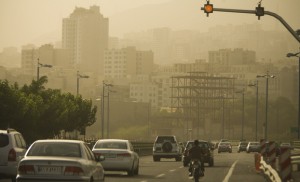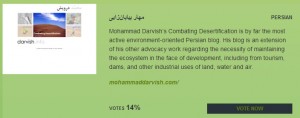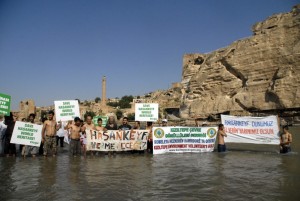Mohammad Darvish is on an often lonesome quest to elevate Iran’s environmental IQ, even daring to oppose nuclear power. So far Iran’s leaders are tolerating it.

Mohammad Darvish, who works at a state-run botanical reserve on the outskirts of Tehran,
is on a mission to warn Iran about the environmental perils facing the nation. (December 4, 2012)
By Ramin Mostaghim and Alexandra Sandels, Los Angeles Times
December 4, 2012
TEHRAN — His son is named after the river born where the Tigris and Euphrates meet. His wife once complained that he loved a rare species of yellow deer more than her.
His realm runs from sprawling salt deserts to the snowcapped peaks of the Zagros Mountains, from southern marshes along the Persian Gulf to damp northern forests known as the “cloud jungle.”
Mohammad Darvish, 47, is Iran’s green gladiator, engaged in a quixotic, often lonesome quest to elevate his homeland’s environmental IQ. In a nation where security and economic concerns overshadow threats to a varied and fragile ecosystem, he even dares to oppose nuclear power, sacrosanct to Iran’s leaders.
“It is budding, but it is far from being a movement,” the indefatigable Darvish says of environmental consciousness in Iran. “But I am sure the environment will be a full-fledged movement one day, and Iran will have Green [political] parties that will send members to parliament.”
Darvish, working from a state-run botanical reserve on the western outskirts of this traffic-clogged capital, is a subtle but persistent voice, direct but non-threatening in his message as he warns about desertification, deforestation, pollution, climate change and other perils to this mostly arid land.
Unlike the country’s understandably edgy political activists, who face the constant threat of police harassment, Darvish has a carefree demeanor. Each Sunday, he spreads his message in a morning spot on state TV. He also writes a widely read environmental column in a moderate newspaper and a blog focusing on Iran’s ecology.
As in the West, much of the public discussion about Iran among its citizens focuses on the sanctions-driven economic crisis and the cataclysmic prospect of war, both related to Tehran’s nuclear development efforts.
The West and Israel allege that Iran harbors a hidden agenda to build an atomic bomb. Tehran contends that its research is for purely peaceful purposes: energy generation and the production of isotopes for cancer treatment.
Iran’s ever-vigilant information overseers have tolerated Darvish’s anti-nuclear advocacy, perhaps in part because the theme is a relatively discreet one in his work, far from a crusade. His opposition is based on ecological threats, he emphasizes, not strategic ones.
“I am not a nuclear scientist, but I believe producing nuclear energy to be used for electricity is too costly and prone to environmental hazards,” Darvish says, sitting on a bench in a wooden cabin on the reserve’s rambling grounds.
“In any natural disaster, or if Israel attacks us, then nuclear pollution is our most dangerous hazard.… Why should we increase our vulnerability by using nuclear plants for energy, while more environmentally friendly technology is available?”
Darvish avoids polemics. As a public worker — he is one of several managers at the state reserve — his preferred style is to address issues, not attack officials.
“Darvish, at the end of the day, is a state employee and civil servant,” says Naser Karami, a climatologist and editor of an environmental news agency who agrees with many of Darvish’s positions.
Karami says Iranians are “being told one lie after the other” about environmental threats in a country that doesn’t get high marks for safeguarding its natural heritage.
Iran ranked 114th among 132 nations in 2012 on the so-called Environmental Performance Index, which tracks various indicators of environmental public health and ecosystem vitality. Switzerland ranked No. 1; Iraq finished last. (The United States, where the index was developed on a pair of Ivy League campuses, ranked 49th, just ahead of Argentina and behind Australia.)
The air was so polluted in Tehran this week that Iranian authorities announced Monday that schools and state-run offices would be closed Tuesday and Wednesday, essentially shutting down much of the capital.
Darvish, a native of Tehran who has a master’s degree in environmental management from Tehran University, traces his passion to childhood trips to the zoo and summers spent at his grandfather’s rural home. There he was exposed to livestock, wildlife and a sense of liberation.
“I strolled and daydreamed,” he recalls of that youthful idyll.
Iranians are not impervious to environmental concerns. The Internet and a growing eco-tourism sector have helped raise awareness. Road construction and pipeline-laying in sensitive areas stir up public emotions, as do emissions-linked urban air pollution and oil contamination.
“There is much more awareness” compared with a decade ago, says Darvish. Still, he says, environmental activism remains largely confined to elite circles. It is well off the radar screens of most Iranians, who are focused on paying bills and feeding their families.
“For me, social problems and economic concerns are the top priority,” says Ali Moueni, 20, a film and theater student interviewed in a Tehran cafe, who said he had never heard of Darvish. “Environmental issues are secondary, but they sometimes catch my eye.”
Others are more engaged.
“I think environmental issues are important and Iran is facing a sort of quandary, or two options,” says Masoud Loghman, 29, a cultural editor who follows Darvish’s writings. “One is to let urbanization continue at the expense of total destruction of the environment, or to focus on sustained growth with environmentally friendly industries and lifestyles.”
Navy: No U.S. drones missing after Iran claim
Illegal exports to Iran on the rise, say U.S. officials
Iran has increased nuclear enrichment capacity, IAEA report says
Middle East shifts may weaken Iran’s influence with Palestinians
Iran police official reportedly fired over Sattar Beheshti death
Preservation is clearly not a priority for Iran’s rulers, desperate for economic development amid crushing Western sanctions linked to the nuclear program. But even amid widespread economic uncertainty, signs of nascent awareness are unmistakable, as are government responses.
Last year, authorities arrested dozens who rallied to save shrinking Lake Urmia, one of the world’s largest salt lakes, now ravaged by drought and the damming of feeder rivers in Iran’s northwest. Officials said the protesters were arrested for demonstrating without a permit, but some activists suspected hostility against ethnic Azeris, the predominant population in the area.
Besides his stand against nuclear energy, Darvish has also voiced opposition to a mega-project that would transport desalinated Caspian Sea water to the parched northern city of Semnan, a cherished proposal of President Mahmoud Ahmadinejad. Darvish has labeled the project a technical and natural folly. But he says he hasn’t faced any retribution.
Iran’s leadership does seem distressed about the massive dust storms that blow in with ever-increasing frequency from neighboring Iraq, usually in the spring and summer. The dust limits visibility, causes respiratory ailments and prompts residents of some border-area cities to don gauze masks.
Sometimes, the storms reach as far as Tehran, near Darvish’s snug office on the lush 360-acre state reserve, which is managed by Iran’s Research Institute of Forestry and Rangelands, Darvish’s employer.
The sanctuary, technically known as a herbarium, was established in the 1960s, during the era of Iran’s pro-Washington monarchy, in collaboration with U.S. botanists.
Here, female gardeners bicycle along dirt paths that wind through verdant microclimates and artificial forests. Native species coexist with exotic trees from Japan and elsewhere, many labeled with their scientific designations. Water cascades from a trio of waterfalls. Several man-made lakes mimic the marine landscape near the Caspian Sea, an area once home to the Caspian tiger, now extinct.
In the evenings, Darvish returns to the city and often shares vegetarian fare with his son, Arvand, 12, who was given the Persian name of a river known in Arabic as the Shatt al Arab, which forms part of the marshy southern border between Iran and Iraq. The waterway’s environs were killing fields during the Iran-Iraq war of the 1980s.
Although his country is in turmoil again, the self-styled watchdog of Iran’s natural world finds a measure of peace and tranquillity in his botanic refuge.
“I walk in this haven,” Darvish says, “to feel better and refresh myself.”
Special correspondents Mostaghim reported from Tehran and Sandels from Beirut. Times staff writer Patrick J. McDonnell in Beirut contributed to this report.






 Iran
Iran 


